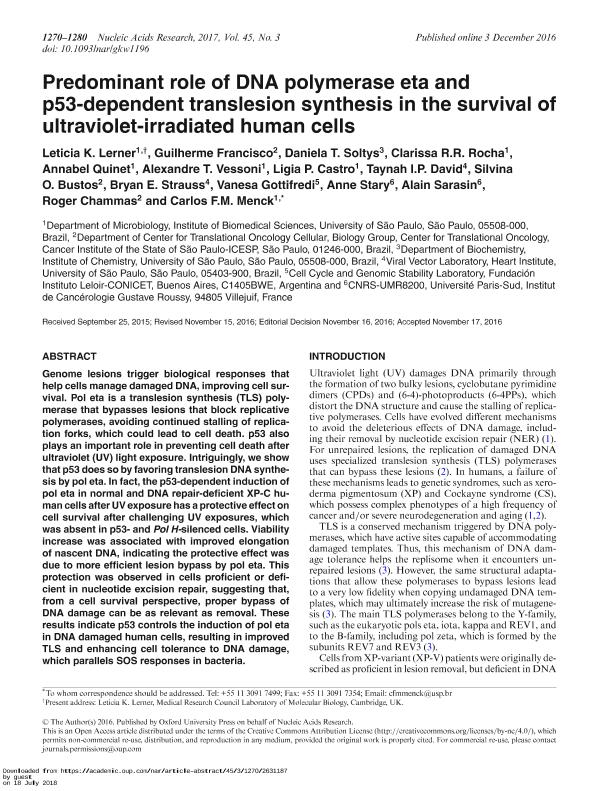Artículo
Predominant role of DNA polymerase eta and p53-dependent translesion synthesis in the survival of ultraviolet-irradiated human cells
Lerner, Leticia K.; Francisco, Guilherme; Soltys, Daniela T.; Rocha, Clarissa R.R.; Quinet, Annabel; Vessoni, Alexandre T.; Castro, Ligia P.; David, Taynah I.P.; Bustos, Silvina O.; Strauss, Bryan E.; Gottifredi, Vanesa ; Stary, Anne; Sarasin, Alain; Chammas, Roger; Menck, Carlos F.M.
; Stary, Anne; Sarasin, Alain; Chammas, Roger; Menck, Carlos F.M.
 ; Stary, Anne; Sarasin, Alain; Chammas, Roger; Menck, Carlos F.M.
; Stary, Anne; Sarasin, Alain; Chammas, Roger; Menck, Carlos F.M.
Fecha de publicación:
02/2017
Editorial:
Oxford University Press
Revista:
Nucleic Acids Research
ISSN:
0305-1048
e-ISSN:
1362-4962
Idioma:
Inglés
Tipo de recurso:
Artículo publicado
Clasificación temática:
Resumen
Genome lesions trigger biological responses that help cells manage damaged DNA, improving cell survival. Pol eta is a translesion synthesis (TLS) polymerase that bypasses lesions that block replicative polymerases, avoiding continued stalling of replication forks, which could lead to cell death. p53 also plays an important role in preventing cell death after ultraviolet (UV) light exposure. Intriguingly, we show that p53 does so by favoring translesion DNA synthesis by pol eta. In fact, the p53-dependent induction of pol eta in normal and DNA repair-deficient XP-C human cells after UV exposure has a protective effect on cell survival after challenging UV exposures, which was absent in p53- and Pol H-silenced cells. Viability increase was associated with improved elongation of nascent DNA, indicating the protective effect was due to more efficient lesion bypass by pol eta. This protection was observed in cells proficient or deficient in nucleotide excision repair, suggesting that, from a cell survival perspective, proper bypass of DNA damage can be as relevant as removal. These results indicate p53 controls the induction of pol eta in DNA damaged human cells, resulting in improved TLS and enhancing cell tolerance to DNA damage, which parallels SOS responses in bacteria.
Palabras clave:
P53
,
Tranlesion Dna Synthesis
,
Sos Response
Archivos asociados
Licencia
Identificadores
Colecciones
Articulos(IIBBA)
Articulos de INST.DE INVEST.BIOQUIMICAS DE BS.AS(I)
Articulos de INST.DE INVEST.BIOQUIMICAS DE BS.AS(I)
Citación
Lerner, Leticia K.; Francisco, Guilherme; Soltys, Daniela T.; Rocha, Clarissa R.R.; Quinet, Annabel; et al.; Predominant role of DNA polymerase eta and p53-dependent translesion synthesis in the survival of ultraviolet-irradiated human cells; Oxford University Press; Nucleic Acids Research; 45; 3; 2-2017; 1270-1280
Compartir
Altmétricas



